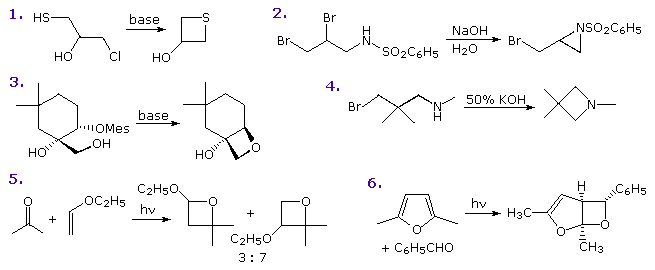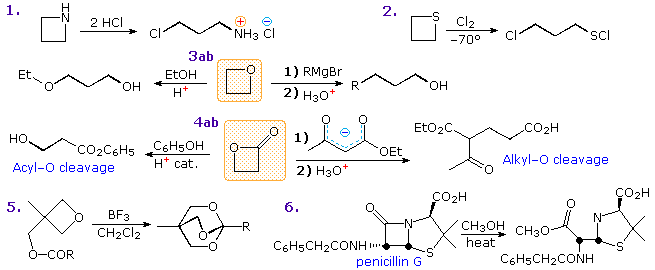Four-Membered Rings
Preparation
Several methods of preparing four-membered heterocyclic compounds are shown in the following diagram. The simple procedure of treating a 3-halo alcohol, thiol or amine with base is generally effective, but the yields are often mediocre. Dimerization and elimination are common side reactions, and other functions may compete in the reaction. In the case of example 1, cyclization to an oxirane competes with thietane formation, but the greater nucleophilicity of sulfur dominates, especially if a weak base is used. In example 2 both aziridine and azetidine formation are possible, but only the former is observed. This is a good example of the kinetic advantageof three-membered ring formation. Example 4 demonstrates that this approach to azetidine formation works well in the absence of competition. Indeed, the exceptional yield of this product is attributed to the gem-dimethyl substitution, the Thorpe-Ingold effect, which is believed to favor coiled chain conformations. The relatively rigid configuration of the substrate in example 3, favors oxetane formation and prevents an oxirane cyclization from occurring. Finally, the Paterno-Buchi photocyclizations in examples 5 and 6 are particularly suited to oxetane formation.

Reactions
Reactions of four-membered heterocycles also show the influence of ring strain. Some examples are given in the following diagram. Acid-catalysis is a common feature of many ring-opening reactions, as shown by examples 1, 2 & 3a. In the thietane reaction (2), the sulfur undergoes electrophilic chlorination to form a chlorosulfonium intermediate followed by a ring-opening chloride ion substitution. Strong nucleophiles will also open the strained ether, as shown by reaction 3b. Cleavage reactions of β-lactones may take place either by acid-catalyzed acyl exchange, as in 4a, or by alkyl-O rupture by nucleophiles, as in 4b. Example 5 is an interesting case of intramolecular rearrangement to an ortho-ester. Finally, the β-lactam cleavage of penicillin G (reaction 6) testifies to the enhanced acylating reactivity of this fused ring system. Most amides are extremely unreactive acylation reagents, thanks to stabilization by p-π resonance. Such electron pair delocalization is diminished in the penicillins, leaving the nitrogen with a pyramidal configuration and the carbonyl function more reactive toward nucleophiles.

Reference
http://www2.chemistry.msu.edu/faculty/reusch/VirtTxtJml/heterocy.htm#top1
 الاكثر قراءة في مواضيع عامة في الكيمياء العضوية
الاكثر قراءة في مواضيع عامة في الكيمياء العضوية
 اخر الاخبار
اخر الاخبار
اخبار العتبة العباسية المقدسة


